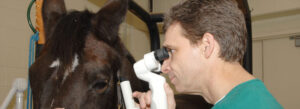July 2020 Research Roundup

A look at some of the latest published research from the NC State College of Veterinary Medicine.
Uncovering Canine Genetic Mutations
An NC State-led study has identified a naturally occurring mutation in Boykin spaniels that causes a severe form of X-linked myotubular myopathy comparable to the human form of the genetic disorder.
For the study, published in Neuromuscular Disorders, a 3-month-old male Boykin spaniel with progressive weakness underwent physical and neurological examination, including a muscle biopsy and whole genome sequencing. The whole genome sequencing uncovered a mutation impacting the MTM1 gene that guides the production of the myotubularin enzyme, which is involved in the development and maintenance of muscle cells.
Male puppies affected by the mutation develop a severe, fatal phenotype. X-linked myotubular myopathy affects muscles used for movement, with motor skills such as standing and walking often impacted.
Natasha Olby is the corresponding author of the study, with co-authors including Kate Meurs, Dylan DeProspero, Julien Guevar, Jeanie Lau and Oriana Yost.
Read the study here.
New Sedation Methods for Cats
A type of oral transmucosal gel induced moderate sedation with minimal undesirable side effects in healthy cats, according to a new study co-authored by Kristen Messenger.
The research, published in the Journal of Feline Medicine and Surgery, describes the use of oral transmucosal (OTM) detomidine gel on the cats. The pharmacokinetic profile supports short-term, minimally invasive sedation in the species using OTM detomidine gel.
Researchers note that further studies are warranted to assess its safety for use in debilitated cats or prior to general anesthesia.
Read the study here.
Investigating the Cause of Equine Squamous Cell Carcinoma

A new study shows support for the potential association between Equus caballus papillomavirus-2 (EcPV-2) and squamous cell carcinoma (SCC) in horses.
Squamous cell carcinoma is the most common neoplasm of the equine stomach, though the mechanisms underlying malignant transformation are unknown. Researchers performed polymerase chain reaction (PCR) on samples of gastric SCCs and on gastric samples from horses with no SCC.
The PCR for EcPV-2 was positive in 64% of gastric SCCs; all non-SCC gastric samples were negative. Signals for EcPV-2 nucleic acid were also detected in tumor cells in 45% of gastric SCCs, but no such signals were detected in any of the non-SCC gastric cases.
Jennifer Luff, Keith Linder, Trevor Rose, Susan May and Elizabeth Alloway are among the authors of the study, published in Veterinary Pathology.
Read the study here.
Emerging Diseases of Rabbits
A comprehensive look at the emerging diseases of rabbits outlines multiple infectious organisms causing such diseases, including rabbit hemorrhagic disease virus-2 (RHDV-2) that is causing fatal viral hepatitis similar to classic RHDV strains.
The study, co-authored by Olivia Petritz and published in Veterinary Clinics of North America: Exotic Animal Practice, describes RHDV-2 as a new variant that has evolved to be highly pathogenic, infecting rabbits as young as 30 days old. Cases have been confirmed in the United States, particularly in the Southwest.
The report also outlines that while mycobacteriosis in rabbits is rare, infections with both nontuberculosis and tuberculosis mycobacterium have been reported in wild and domestic rabbits. Among the other key findings: Hepatitis E is described as an emerging zoonotic disease in humans, with certain strains having a high prevalence in wild, farmed and laboratory rabbits, which are often asymptomatic for the virus.
Read the study here.
Effective Treatments for Equine Keratitis
The antifungal drug luliconazole has potential to treat equine fungal keratitis, according to a study with authors Brian Gilger and Darby Roberts published in Veterinary Ophthalmology.
The study looked at concentrations of four fungal species isolated from horses in the southeastern United States with equine fungal keratitis after being treated with five previously untested azole, echinocandin and carboxamide antifungal drugs. Fungal keratitis, an infection that can develop after an injury to the cornea, is common in horses.
Luliconazole exhibited increased growth inhibition against both Aspergillus and Fusarium fungal species in the study compared to commonly used, standard antifungal drugs.
Read the study here.
Treating Fungal Infections in Penguins
A preliminary pilot study co-authored by Mark Papich finds evidence that an oral itraconazole solution should be considered for future study as a cost-effective treatment for aspergillosis in African penguins and other avian species.
Aspergillosis, a type of fungal infection usually of the lungs, is a common cause of morbidity and mortality in captive penguins. The antifungal drug itraconazole is commonly used to treat aspergillosis infections in birds, but commercially available human formulations are costly.
The study tested a new veterinary formulation of itraconazole named Itrafungol that has been approved by the United States Food and Drug Administration for use in cats. A 20mg itraconazole dose was administered to nine African penguins. The drug was absorbed in all penguins, and plasma concentrations in five of the nine penguins were found to be greater than the established therapeutic dose.
Larger sample size studies are warranted to further explore the drug as an effective treatment for avian species.
The research was published in the Journal of Avian Medicine and Surgery.
Read the study here.
E. coli Transmission on Sustainable Farms

The first study of Escherichia coli transmission on commercial sustainable farms in two states shows antimicrobial-resistant transmission of the bacterium between animal feeding operations and fresh produce.
The study aimed to determine the transmission of Shiga toxin-producing E. coli (STEC) or enteric pathogens from small and large animal herds or operations to fresh produce on sustainable farms in Tennessee and North Carolina.
Samples were collected from raw and composted manure, environment and produce sources. Serotype, virulence and genotypic resistance profiles were determined using whole genome sequence.
E. coli prevalence increased during the summer season for all tested sources. Ten isolates were identified as serotype 045, which is associated with a group frequently linked with foodborne outbreaks. The majority, 55%, of the E. coli were multidrug resistant.
Sid Thakur is the corresponding author of the study, and Ayanna Glaize is one of its authors. The International Journal of Food Microbiology published the research.
Read the study here.
~Jordan Bartel/NC State Veterinary Medicine


